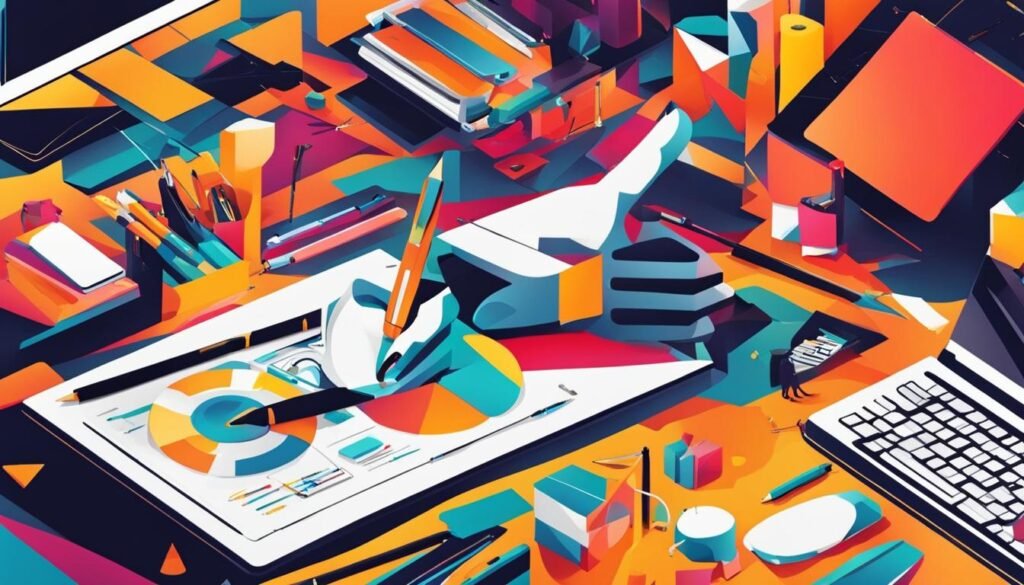
In the dynamic realm of graphic design, the fusion of creativity and entrepreneurship opens doors to diverse income streams. As a graphic designer, navigating the path to financial success requires a strategic approach that goes beyond conventional employment. This guide will provide valuable tips and insights on how to make money with graphic design, including building a strong foundation, exploring freelancing opportunities, creating passive income streams, establishing an online presence, networking and collaborations, diversifying service offerings, managing finances and pricing strategies, adapting to new technology trends, staying inspired, and future-proofing your career. Join us as we uncover the keys to thriving in the competitive world of graphic design and unlocking your earning potential.
Key Takeaways:
- Build a standout portfolio showcasing your versatility and proficiency in various design styles.
- Stay updated on industry trends and master essential design tools to remain relevant.
- Explore freelance opportunities on platforms like Upwork or Fiverr and build strong client relationships.
- Diversify your income by creating and selling digital assets, fonts, or icon sets.
- Establish an online presence through a professional website and active engagement on social media.
Building a Strong Foundation
A robust foundation is essential for a thriving career in graphic design. To establish yourself as a talented and sought-after graphic designer, focus on the following key elements:
- Building a Graphic Design Portfolio: Create a standout portfolio that showcases your versatility, creativity, and technical skills. Include a diverse range of projects that demonstrate your ability to work with various styles and mediums.
- Mastering Essential Design Tools: Stay updated on the latest design tools and software to ensure that your skill set remains relevant in a rapidly evolving industry. Familiarize yourself with popular software like Adobe Photoshop, Illustrator, and InDesign, as well as emerging tools that can enhance your design capabilities.
- Staying Updated on Industry Trends: Keep a pulse on the latest trends and developments in the graphic design industry. Subscribe to design blogs and newsletters, follow influential designers and design communities on social media, and attend design conferences to stay informed and inspired.
- Showcasing Real-World Projects: While conceptual designs are valuable, including real-world projects in your portfolio provides concrete evidence of your skills and capabilities. Highlight projects that you have completed for clients, employers, or personal initiatives to demonstrate your ability to deliver professional, high-quality work.
- Highlighting Client Collaborations: Collaborating with clients is an integral part of the graphic design process. Showcase projects where you have worked closely with clients, detailing your role, the challenges faced, and the successful outcomes achieved. This demonstrates your ability to collaborate effectively and meet client expectations.
By focusing on these elements, you can build a strong foundation that showcases your expertise, keeps you updated on industry trends, and attracts potential clients and employers.
Exploring Freelancing Opportunities
Freelancing offers tremendous opportunities for artistic and financial growth in the graphic design industry. It allows you to have autonomy over your work and explore diverse projects that align with your creative vision. To kickstart your freelancing journey and find lucrative graphic design work, here are some key steps:
Create a Compelling Profile on Freelancing Platforms
One of the first steps to finding freelance graphic design work is to create a compelling profile on popular freelancing platforms such as Upwork or Fiverr. Your profile serves as the virtual representation of your skills and expertise, so it is crucial to make it stand out. Emphasize your unique creative flair, highlight your past projects, and showcase a portfolio that demonstrates your versatility and proficiency in various design styles.

Build Effective Client Relationships
Building effective client relationships is vital for freelancers. Excellent communication is key to understanding client requirements, clarifying expectations, and delivering outstanding work. Collaborate closely with clients throughout the project lifecycle, seeking their feedback and offering your expertise to drive successful outcomes. By establishing trust and delivering quality work consistently, you can foster long-term client relationships and increase referrals.
Deliver Quality Work Consistently
Consistency is crucial in freelancing. Delivering high-quality work consistently not only satisfies your current clients but also strengthens your reputation in the industry. Strive to exceed client expectations by paying attention to detail, staying updated on design trends, and constantly sharpening your skills. Your commitment to delivering exceptional work will set you apart from competitors and attract new clients.
Foster a Positive Reputation
Word-of-mouth is a powerful tool in the freelancing world. Cultivate a positive reputation by providing an exceptional client experience. Encourage clients to leave reviews and testimonials on your profile, showcasing your professionalism and the quality of your work. Actively engage with the design community online, participate in relevant forums, and share your knowledge to establish yourself as a reputable and respected graphic designer.
Remember, freelancing requires dedication, discipline, and the ability to adapt to different client needs. By creating a compelling profile, building effective client relationships, delivering quality work consistently, and fostering a positive reputation, you can unlock a world of freelance graphic design opportunities and take your career to new heights.
Creating Passive Income Streams
Generating passive income is a smart strategy for graphic designers looking to boost their earning potential. By monetizing your graphic design assets, you can generate revenue beyond client projects and commissions, providing stability while allowing you to focus on your creative pursuits.
Monetizing Graphic Design Assets
One way to generate passive income is by creating and selling digital assets. Consider designing and marketing fonts or icon sets, which are in high demand and can be sold on platforms like Shopify or Creative Market. Additionally, you can create stock graphics, illustrations, templates, or other digital assets that designers and creative professionals can purchase and use in their projects.
Selling Online Courses
Another avenue for passive income is to create and sell online courses that share your unique expertise with a global audience. You can teach aspiring designers or individuals looking to enhance their design skills and knowledge. Platforms such as Udemy or Teachable offer a user-friendly interface for creating and selling your courses, allowing you to earn income even while you sleep.
“Creating passive income streams is not only about diversifying your revenue sources but also about leveraging your skills and knowledge to reach a broader audience.”
Diversifying Your Income Streams
To maximize your earning potential, it’s essential to diversify your income streams. By offering a variety of products and services, you can cater to different customer needs and tap into various revenue streams simultaneously. Consider combining the sale of digital assets with freelance design work or offering design consultations to clients looking for professional guidance and expertise.
Benefits of Passive Income
Generating passive income as a graphic designer enables you to break free from the reliance on individual client projects, providing a more stable and predictable income. It allows you to focus on honing your design skills, exploring new creative ventures, or investing your time in passion projects that may not be financially lucrative upfront but have long-term potential.
| Benefits of Creating Passive Income Streams |
|---|
| 1. Financial stability beyond client projects |
| 2. Freedom to focus on creative pursuits |
| 3. Diversification of income sources |
| 4. Potential for scalability and growth |
By monetizing your graphic design assets and creating passive income streams, you can unlock new financial opportunities and gain more control over your career as a graphic designer.
Establishing an Online Presence
In the digital age, establishing a strong online presence is crucial for graphic designers. Building a personal brand and maintaining consistency in your visual identity across various platforms are key steps in gaining recognition and attracting potential clients. Engaging with the design community on social media can help you foster connections, stay updated with industry trends, and showcase your expertise.
Creating a professional website is essential for showcasing your portfolio, articulating your design philosophy, and detailing your services. It serves as a central hub where potential clients can learn more about your work and contact you for projects. Additionally, blogging about design trends not only positions you as an authority in the field but also helps enhance your website’s search engine visibility.
By investing time and effort into building and maintaining a compelling online presence, you can establish yourself as a reputable graphic designer and open doors to professional opportunities.
To further enhance your online presence, consider incorporating the following strategies:
- Create Consistency: Ensure that your visual identity (such as logo, color palette, and typography) remains consistent across all your online platforms, including social media profiles, website, and portfolio.
- Engage with the Design Community: Actively participate in design-related discussions, share your work, and support fellow designers on social media platforms such as Instagram, Behance, or Dribbble. This not only helps you build connections but also increases your visibility within the industry.
- Showcase Your Work: Regularly update your online portfolio with your latest projects, highlighting your diverse skills and expertise. This allows potential clients to see your capabilities and understand your design style.
Blogging about Design Trends
Blogging about design trends can significantly contribute to your online presence. By sharing your insights and expertise, you establish yourself as a thought leader in the industry. Additionally, writing relevant blog posts can help enhance your website’s visibility in search engine results, driving more traffic to your site and potentially attracting new clients.
Consider writing blog posts on topics such as:
- The latest design trends and how they impact various industries
- Best practices for graphic design and tips for aspiring designers
- Case studies showcasing successful design projects you have worked on
Remember to optimize your blog posts with relevant keywords to improve search engine visibility. Including high-quality visuals and sharing your blog content on social media can also help attract a wider audience.
Establishing a strong online presence requires consistent effort and dedication. By investing in building a personal brand, engaging with the design community, creating a professional website, and blogging about design trends, you can enhance your visibility, attract potential clients, and position yourself as a reputable graphic designer.

Networking and Collaborations
Networking and collaborations are essential for success in the graphic design industry. Not only do they expand your professional network, but they also unlock the potential for innovative and impactful work that resonates in the competitive landscape of design.
Joining design communities and forums is a great way to interact with fellow designers and broaden your perspective on what’s possible within the medium. By participating in discussions, sharing insights, and seeking feedback, you can tap into a wealth of collective knowledge and stay inspired.
Attending industry events and conferences provides opportunities for face-to-face interactions with potential clients, collaborators, and industry leaders. These events offer a platform to showcase your work, exchange ideas, and forge meaningful connections that can lead to exciting collaborations.
Exploring collaborative opportunities is another avenue to consider. Collaborating with peers or clients brings diverse perspectives to your creative process, fostering innovation and allowing you to tap into the collective genius of a team. By combining your skills and expertise with others, you can create truly remarkable and impactful design projects.
“Collaboration is the key to unlocking a world of possibilities in graphic design. By working together, we can achieve extraordinary results that go beyond the limitations of individual perspectives.” – Design Guru
Networking and collaborations not only enhance your professional growth but also open doors to new clients, projects, and opportunities. Embrace the power of connections and tap into the collective creative energy within the design community to take your graphic design career to new heights.

Benefits of Networking and Collaborations in Graphic Design
- Access to diverse perspectives and insights
- Opportunities for inspiration and staying updated on industry trends
- Potential for exciting collaborations and joint projects
- Expanded professional network and connections
- Sharing of knowledge, experiences, and resources
- Possibility of unlocking new clients and business opportunities
Diversifying Service Offerings
Diversifying your service offerings is vital in the ever-evolving landscape of graphic design. By expanding into branding and marketing consultancy, you can broaden your professional scope and cater to a broader client base. Position yourself as a holistic creative partner capable of elevating a brand’s identity and market presence.
Exploring 3D modeling or animation services is another avenue to consider. With the growing demand for immersive and visually engaging content, adding a dynamic dimension to your skill set will enable you to meet client demands and stand out in the industry.
By diversifying your service offerings, you position yourself as a versatile and adaptable professional, capable of catering to a wider range of client needs. This not only ensures your relevance in a competitive market but also enables you to future-proof your career.
Benefits of Diversification
When you expand into branding and marketing consultancy, you position yourself as a strategic partner for businesses. By understanding their goals and values, you can design cohesive visual identities that effectively communicate their brand message.
Exploring 3D modeling or animation services allows you to create visually stunning content that captivates audiences and gives brands a competitive edge. This skillset opens doors to a broader range of creative opportunities, from product visualization to virtual reality experiences.
By diversifying your service offerings, you become a holistic creative partner, capable of delivering comprehensive solutions that align with your clients’ goals and aspirations.
List of Diversified Services
| Service Offerings | Benefits |
|---|---|
| Branding and Marketing Consultancy | Position yourself as a strategic partner and help clients effectively communicate their brand message. |
| 3D Modeling or Animation Services | Create visually stunning content and stand out in a competitive market. |
By expanding into branding and marketing consultancy, and exploring 3D modeling or animation services, you not only meet client demands but also position yourself as a holistic creative partner. Embrace the diverse opportunities available in the graphic design industry, and cater to a broader client base to maximize your professional growth and success.

Managing Finances and Pricing Strategies
Managing your finances and implementing effective pricing strategies is crucial for the success of your graphic design career. By setting competitive and fair pricing, evaluating the market, understanding your competition, and appraising your unique value, you can position yourself for financial growth. Here are key steps to help you navigate the financial aspect of your graphic design business:
- Evaluate the market: Understand the current market rates and industry standards for graphic design services. Research the pricing strategies used by other designers to gain insight into how to position yourself.
- Set competitive and fair pricing: Based on your skills, experience, and the unique value you bring to each project, establish pricing that reflects the quality and expertise you offer. Ensure that your rates are competitive while also considering the value you provide to clients.
- Track income and expenses: Keep a detailed record of your income and expenses to maintain a clear financial overview. This will enable you to make informed decisions regarding budgeting, investment, and profitability.
- Leverage accounting tools: Take advantage of accounting tools designed specifically for freelancers. These tools can simplify financial management by automating tasks such as invoicing, expense tracking, and tax calculations.
- Plan for taxes: Understand your tax obligations as a graphic designer and plan accordingly. Set aside a portion of your income for taxes and consult with a tax professional to ensure compliance and optimize your tax strategy.
- Establish a savings mechanism: Build financial security by establishing a savings mechanism. Set aside a percentage of each project’s income to create an emergency fund and save for future investments or business growth.
By implementing these strategies, you can manage your finances effectively, optimize your pricing, and ensure long-term financial stability as a graphic designer.
Adapting to New Technology Trends
As a graphic designer, staying relevant and competitive in the industry requires embracing new technology trends. One of the most exciting advancements is the integration of artificial intelligence (AI) in graphic design. By embracing AI, you can take your designs to new heights and unlock a world of creative possibilities.
Utilizing AI-generated images is an innovative approach to graphic design. AI algorithms can generate unique and visually stunning images that can inspire your designs and enhance your creative process. These AI-generated images can serve as a valuable source of inspiration, allowing you to explore new styles, color palettes, and compositions.
To stay at the forefront of the industry, it’s crucial to stay updated on technological advancements. The world of graphic design is constantly evolving, with new tools and techniques emerging regularly. By keeping yourself informed about the latest trends and developments, you can ensure that your work remains fresh and cutting-edge.
Don’t be afraid to experiment with new design tools and techniques. As technology advances, new design software and applications are continually being introduced. Embracing these tools and incorporating them into your workflow can help you streamline your processes and achieve higher levels of efficiency and productivity.
Leveraging AI for Automation and Efficiency
“AI has the potential to revolutionize the graphic design industry, enabling designers to automate repetitive tasks and focus on the creative aspects of their work.”
Leveraging AI for automation and efficiency can have a transformative impact on your graphic design process. AI-powered tools can automate repetitive tasks, such as resizing images or generating mockups, allowing you to save valuable time and energy. By relying on AI for these tasks, you can focus on the more creative aspects of your work, such as concept development and ideation.
The application of AI in graphic design is not about replacing human creativity, but rather enhancing it. By leveraging AI for automation and efficiency, you can take on more projects, meet tight deadlines, and deliver exceptional results.
Adapting to new technology trends is essential for graphic designers in today’s fast-paced industry. By embracing AI in graphic design, utilizing AI-generated images, staying updated on technological advancements, experimenting with new design tools, and leveraging AI for automation and efficiency, you can position yourself as an innovative and forward-thinking designer.
Staying Inspired and Future-Proofing Your Career
As a graphic designer, staying inspired is crucial for maintaining a successful career in the ever-evolving creative industry. Finding sources of inspiration is like fuel for your creativity. Look to art, design, nature, and other creative outlets to ignite your imagination and spark fresh ideas. Take time to appreciate the beauty around you and let it inspire your work.
Additionally, it’s important to stay updated on new design trends. Explore emerging styles and techniques to keep your designs fresh and relevant. By staying informed, you can incorporate the latest trends into your work and stand out from the competition.
Continuous learning and skill development are vital in a rapidly changing industry. Dedicate time to expand your knowledge and refine your abilities. Take online courses, read design books, and participate in workshops to stay ahead of the curve. By continuously improving your skills, you position yourself as a valuable asset to clients and employers.
Another key aspect of future-proofing your career is staying adaptable and flexible. The graphic design landscape is constantly evolving, with new technologies, client demands, and industry trends emerging. By embracing change and being open to new ideas and opportunities, you can navigate these shifts with ease and maintain a competitive edge.
Remember, future-proofing your career is about more than just surviving; it’s about thriving. Embrace the unknown, challenge yourself, and be willing to take calculated risks. Seek out new experiences and collaborations that push the boundaries of your creativity. By staying adaptable and future-focused, you ensure that your career as a graphic designer remains exciting, fulfilling, and prosperous in the years to come.
Conclusion
Graphic design is a thriving industry that offers countless opportunities to turn your creativity into profit. By utilizing the tips and trends discussed in this guide, you can transform your graphic design skills into a lucrative career. Whether through freelancing, creating passive income streams, diversifying your service offerings, or establishing a strong online presence, there are various avenues to explore for financial success.
However, it’s not just about making money. It’s also essential to manage your finances wisely, stay updated on technology trends, and stay inspired to ensure long-term success. By embracing innovation, continuously improving your skills, and future-proofing your career, you can stay ahead in this dynamic and competitive field.
Remember, the key to thriving as a graphic designer is to remain adaptable and seize opportunities as they arise. Cultivate your creativity and utilize the available resources and platforms to showcase your work and build your brand. With dedication, perseverance, and the right strategies, you can monetize your graphic design skills and create a fulfilling and profitable profession.
FAQ
How can I build a strong foundation as a graphic designer?
Building a strong foundation involves creating a standout portfolio that showcases your skills and versatility, staying updated on industry trends, mastering essential design tools, and including real-world projects and client collaborations in your portfolio.
What are some tips for exploring freelancing opportunities in graphic design?
To explore freelancing opportunities, create a compelling profile on freelancing platforms, curate your past projects, emphasize your skills, build effective client relationships, deliver quality work consistently, and foster a positive reputation within the industry.
How can I create passive income streams as a graphic designer?
Monetize your graphic design skills by creating and selling digital assets such as stock graphics and templates. You can also consider designing and marketing fonts or icon sets, as well as creating and selling online courses that share your expertise with a global audience.
How can I establish a strong online presence as a graphic designer?
Building a personal brand, maintaining consistency in your visual identity across platforms, engaging with the design community on social media, creating a professional website, and blogging about design trends are all effective ways to establish a strong online presence.
Why is networking and collaboration important for graphic designers?
Networking and collaborations help graphic designers expand their professional network, tap into the collective genius of a team, and create innovative and impactful work. Join design communities and forums, attend industry events and conferences, and explore collaborative opportunities to enhance your career.
How can I diversify my service offerings as a graphic designer?
By expanding beyond traditional design services, you can offer branding and marketing consultancy, explore 3D modeling or animation services, and position yourself as a holistic creative partner capable of meeting diverse client demands. Diversifying your service offerings allows you to cater to a broader client base and future-proof your career.
What should I consider when managing finances and pricing my graphic design services?
Set competitive and fair pricing by evaluating the market, understanding the competition, and appraising the unique value you bring to each project. Track your income and expenses, leverage accounting tools for freelancers, plan for taxes, and establish a savings mechanism to ensure financial stability.
How can I adapt to new technology trends as a graphic designer?
Embracing AI in graphic design, utilizing AI-generated images, staying updated on technological advancements, experimenting with new design tools and techniques, and leveraging AI for automation and efficiency can help you stay relevant and competitive in an ever-evolving industry.
How can I stay inspired and future-proof my career as a graphic designer?
Find sources of inspiration through art, design, and other creative outlets. Stay updated on new design trends, continuously learn and develop your skills, stay adaptable and flexible, and embrace new opportunities to future-proof your career in the rapidly changing landscape of graphic design.


